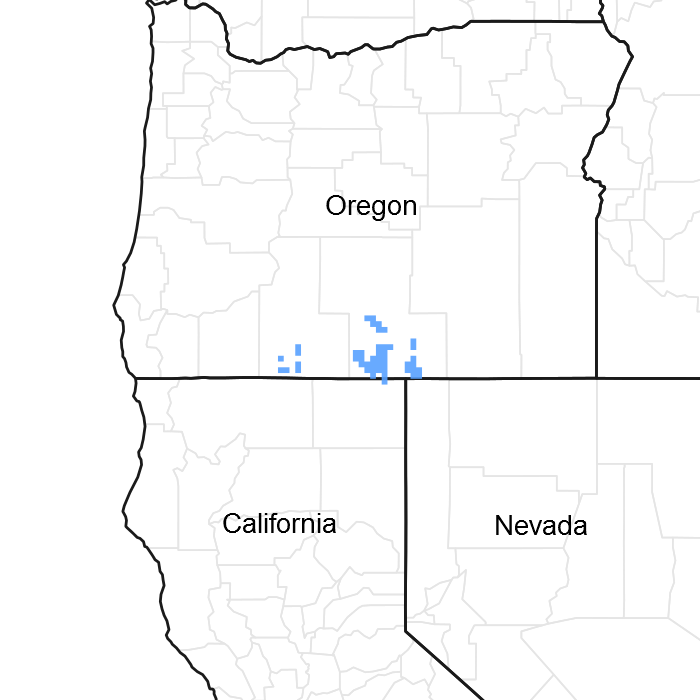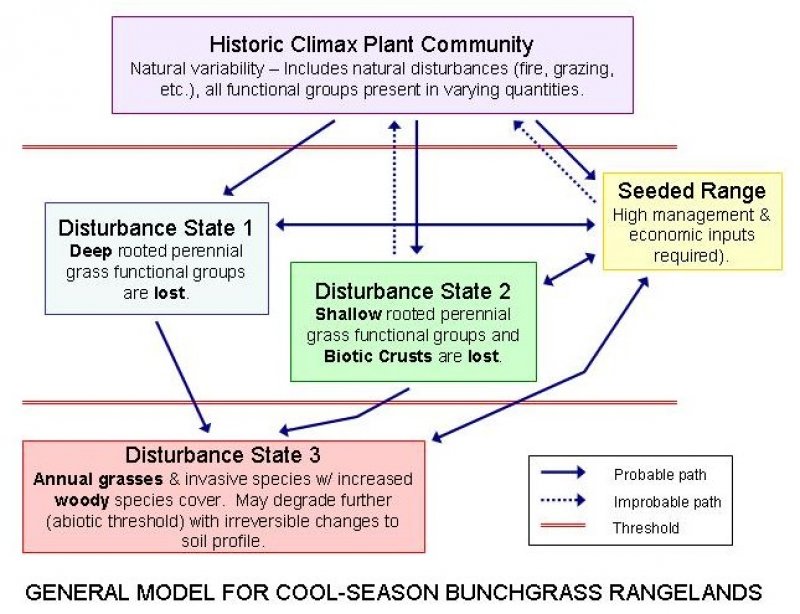
Natural Resources
Conservation Service
Ecological site R021XY108OR
INTERMITTENT LAKE
Accessed: 12/07/2025
General information
Provisional. A provisional ecological site description has undergone quality control and quality assurance review. It contains a working state and transition model and enough information to identify the ecological site.

Figure 1. Mapped extent
Areas shown in blue indicate the maximum mapped extent of this ecological site. Other ecological sites likely occur within the highlighted areas. It is also possible for this ecological site to occur outside of highlighted areas if detailed soil survey has not been completed or recently updated.
Associated sites
| R021XY200OR |
LOAMY 10-14 PZ 10-12 PZ |
|---|---|
| R021XY214OR |
CLAYPAN 14-18 PZ 10-12 PZ |
Table 1. Dominant plant species
| Tree |
Not specified |
|---|---|
| Shrub |
Not specified |
| Herbaceous |
Not specified |
Physiographic features
This site occurs in lake basins and on floodplains and low terraces. These areas are subject to frequent flooding for brief periods during the spring snow melt. After the flood waters recede, water ponds on the surface until late spring.
Table 2. Representative physiographic features
| Landforms |
(1)
Basin floor
(2) Terrace (3) Flood plain |
|---|---|
| Flooding duration | Brief (2 to 7 days) |
| Flooding frequency | Frequent |
| Ponding duration | Brief (2 to 7 days) |
| Ponding frequency | Frequent |
| Elevation | 1,219 – 1,433 m |
| Slope | 0 – 1% |
| Aspect | Aspect is not a significant factor |
Climatic features
The annual precipitation ranges from 10 to 14 inches, most of which occurs in the form of snow during the months of October through March. Additional moisture is supplied to the site by snow melt. The soil temperature regime is mesic with the mean annual air temperature of about 47 degrees F. Temperature extremes range from 100 to -30 degrees F. The frost free period ranges from 70 to 110 days. The optimum period for plant growth is mid-April to mid-July.
Table 3. Representative climatic features
| Frost-free period (average) | 110 days |
|---|---|
| Freeze-free period (average) | 0 days |
| Precipitation total (average) | 356 mm |
Figure 2. Monthly average minimum and maximum temperature
Influencing water features
Soil features
The soils of this site are very deep to bedrock but have a restrictive layer near the surface which impedes permeabiltiy. Typically, the surface layer is clay loam or silty clay loam. The subsoil is clay or sitly clay. Permeability is slow. Runoff is ver slow. Erosion hazard is slight except in early spring during snow melt runoff.
Table 4. Representative soil features
| Surface texture |
(1) Clay loam (2) Silty clay loam |
|---|---|
| Permeability class | Slow |
| Soil depth | 152 cm |
Ecological dynamics
If the condition of the site deteriorates as a result of overgrazing, silver sagebrush will increase. If overgrazing continues, forbs such as povertyweed, will invade the site and silver sagebrush will dominate. Fire will favor silver sagebrush which can resprout from the crowns.
Variability in plant composition on this site results from differences in frequency and duration of ponding. Wetter conditions will favor an increase in creeping wildrye while drier conditions will favor Nevada bluegrass.
State and transition model

More interactive model formats are also available.
View Interactive Models
More interactive model formats are also available.
View Interactive Models
Click on state and transition labels to scroll to the respective text
Ecosystem states
State 1 submodel, plant communities
State 1
HCPC, LETR5-POSE/ARCA13
Community 1.1
HCPC, LETR5-POSE/ARCA13
The potential native plant community is dominated by creeping wildrye, Nevada bluegrass, and silver sagebrush. Significant amounts of dryland sedge, bottlebrush squirreltail, bluegrasses and forbs to occur. Vegetative composition of the community is approximately 85% grasses, 5% forbs, and 10% shrubs.
Figure 3. Annual production by plant type (representative values) or group (midpoint values)
Table 5. Annual production by plant type
| Plant type | Low (kg/hectare) |
Representative value (kg/hectare) |
High (kg/hectare) |
|---|---|---|---|
| Grass/Grasslike | 723 | 1597 | 1160 |
| Shrub/Vine | 168 | 211 | 252 |
| Forb | 67 | 101 | 135 |
| Total | 958 | 1909 | 1547 |
Figure 4. Plant community growth curve (percent production by month). OR5501, D21 Low Elev., NA, Meadow/Lakebed/Irr.. RPC Growth Curve.
| Jan | Feb | Mar | Apr | May | Jun | Jul | Aug | Sep | Oct | Nov | Dec |
|---|---|---|---|---|---|---|---|---|---|---|---|
| J | F | M | A | M | J | J | A | S | O | N | D |
| 0 | 0 | 0 | 5 | 15 | 30 | 35 | 10 | 5 | 0 | 0 | 0 |
Additional community tables
Table 6. Community 1.1 plant community composition
| Group | Common name | Symbol | Scientific name | Annual production (kg/hectare) | Foliar cover (%) | |
|---|---|---|---|---|---|---|
|
Grass/Grasslike
|
||||||
| 1 | Dominant deep rooted perennial grasses | 420–925 | ||||
| beardless wildrye | LETR5 | Leymus triticoides | 420–925 | – | ||
| 2 | Sub-dominant deep rooted perennial grasses | 17–84 | ||||
| sedge | CAREX | Carex | 17–84 | – | ||
| 4 | Sub-dominant shallow rooted perennial grasses | 252–504 | ||||
| Sandberg bluegrass | POSE | Poa secunda | 168–336 | – | ||
| mat muhly | MURI | Muhlenbergia richardsonis | 84–168 | – | ||
| 5 | Other perennial grasses | 34–84 | ||||
| squirreltail | ELEL5 | Elymus elymoides | 0–6 | – | ||
| meadow barley | HOBR2 | Hordeum brachyantherum | 0–6 | – | ||
| rush | JUNCU | Juncus | 0–6 | – | ||
|
Forb
|
||||||
| 7 | Dominant perennial forbs | 50–101 | ||||
| desertparsley | LOMAT | Lomatium | 17–34 | – | ||
| lupine | LUPIN | Lupinus | 17–34 | – | ||
| evening primrose | OENOT | Oenothera | 17–34 | – | ||
| 10 | Other annual forbs | 17–34 | ||||
|
Shrub/Vine
|
||||||
| 11 | Dominant evergreen shrubs | 168–252 | ||||
| silver sagebrush | ARCA13 | Artemisia cana | 168–252 | – | ||
Interpretations
Animal community
This site is used by pronghorn antelope. During periods of inundation, waterfowl will use the site for feeding and resting.
Hydrological functions
The soils are typically in hydrologic group C.
Recreational uses
This site offers birdwatching opportunities. Aesthetically, the site is contrasting in color and texture to surrounding sites.
Other products
This site is easily damaged when the soils are wet. Summer and fall grazing when soils are dry reduces the potential for damage.
Other information
The soils in this site typically reflect hydric soil characteristics. Seeding is limited by high water table, clayey textures and shrink-swell characteristic of the soils. The site is well suited to excavations and dugouts for livestock water and waterfowl use.
Supporting information
Contributors
Barrett, Carlson
E Ersch (OSU)
K.Kennedy
Rangeland health reference sheet
Interpreting Indicators of Rangeland Health is a qualitative assessment protocol used to determine ecosystem condition based on benchmark characteristics described in the Reference Sheet. A suite of 17 (or more) indicators are typically considered in an assessment. The ecological site(s) representative of an assessment location must be known prior to applying the protocol and must be verified based on soils and climate. Current plant community cannot be used to identify the ecological site.
| Author(s)/participant(s) | Jeff Repp |
|---|---|
| Contact for lead author | Oregon NRCS State Rangeland Management Specialist |
| Date | 08/21/2012 |
| Approved by | Bob Gillaspy |
| Approval date | |
| Composition (Indicators 10 and 12) based on | Annual Production |
Indicators
-
Number and extent of rills:
None, slight sheet & rill erosion hazard -
Presence of water flow patterns:
None, except ephemeral flow patterns after spring snow melt -
Number and height of erosional pedestals or terracettes:
None to few: restricted permeability layer near the surface -
Bare ground from Ecological Site Description or other studies (rock, litter, lichen, moss, plant canopy are not bare ground):
20-40% -
Number of gullies and erosion associated with gullies:
None -
Extent of wind scoured, blowouts and/or depositional areas:
None, slight wind erosion hazard -
Amount of litter movement (describe size and distance expected to travel):
Fine - limited movement -
Soil surface (top few mm) resistance to erosion (stability values are averages - most sites will show a range of values):
Significantly resistant to erosion: aggregate stability = 4-6 -
Soil surface structure and SOM content (include type of structure and A-horizon color and thickness):
Very deep (with restrictive layer near the surface), somewhat poorly drained clay loams and silty clay loams: Low to moderate OM (1-2%) -
Effect of community phase composition (relative proportion of different functional groups) and spatial distribution on infiltration and runoff:
Moderate ground cover (30-40%) and gentle slopes (0-1%) effectively limits rainfall impact and overland flow -
Presence and thickness of compaction layer (usually none; describe soil profile features which may be mistaken for compaction on this site):
None -
Functional/Structural Groups (list in order of descending dominance by above-ground annual-production or live foliar cover using symbols: >>, >, = to indicate much greater than, greater than, and equal to):
Dominant:
Creeping wildrye > Sandberg bluegrass > Silver sagebrush > other grasses > sedges > forbsSub-dominant:
Other:
Additional:
-
Amount of plant mortality and decadence (include which functional groups are expected to show mortality or decadence):
Normal decadence and mortality expected -
Average percent litter cover (%) and depth ( in):
-
Expected annual annual-production (this is TOTAL above-ground annual-production, not just forage annual-production):
Favorable: 1800, Normal: 1500, Unfavorable: 1000 lbs/acre/year at high RSI (HCPC) -
Potential invasive (including noxious) species (native and non-native). List species which BOTH characterize degraded states and have the potential to become a dominant or co-dominant species on the ecological site if their future establishment and growth is not actively controlled by management interventions. Species that become dominant for only one to several years (e.g., short-term response to drought or wildfire) are not invasive plants. Note that unlike other indicators, we are describing what is NOT expected in the reference state for the ecological site:
Perennial brush species will increase with deterioration of plant community. Cheatgrass and Medusahead invade sites that have lost deep rooted erennial grass functional groups. -
Perennial plant reproductive capability:
All species should be capable of reproduction annually
Print Options
Sections
Font
Other
The Ecosystem Dynamics Interpretive Tool is an information system framework developed by the USDA-ARS Jornada Experimental Range, USDA Natural Resources Conservation Service, and New Mexico State University.
Click on box and path labels to scroll to the respective text.